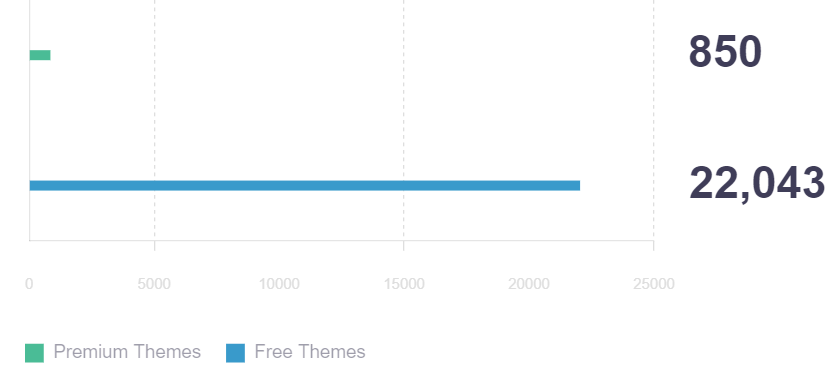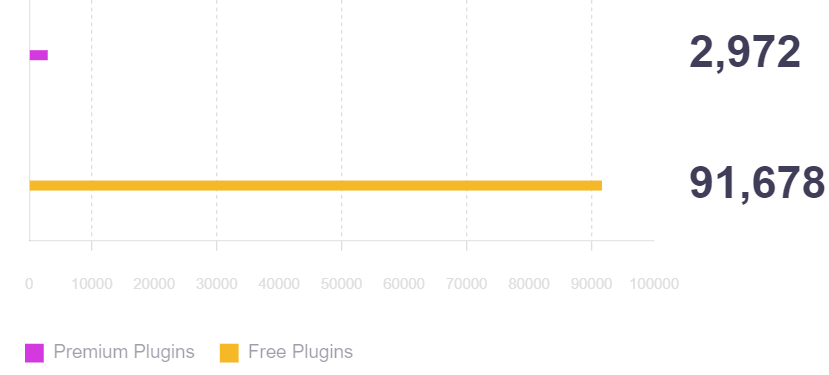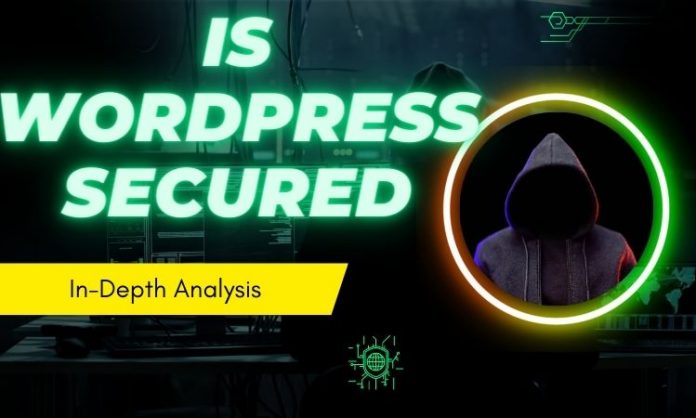WordPress powers almost 40% of websites worldwide. That makes WordPress one of the most popular Content Management systems nowadays, and it’s growing day by day.
There’s a quote like “Everything that has merits must have demerits too,” and this goes for WordPress too.
You might be wondering if WordPress is secure enough or not. Before going for the answer, you have to know some facts regarding WordPress Content Management System.
In recent years WordPress websites got hacked most of the time for easily preventable reasons.
Some of those reasons are:
- WordPress security plugin issues,
- WordPress version issue,
- Theme piracy issue,
- Malicious API integration,
- Improper content management, etc.
Table of Contents
Reasons why your WordPress Site Can Be Hacked?
Everything has vulnerabilities, and disadvantages, but still, it exists; so that we can use it and get benefited. The intelligence doesn’t lie in product comparison; it lies in its proper usage.
For instance, let’s think about a mobile phone, you’ll find disabilities or disadvantages almost equal to their abilities or advantages. But still, people use it, love it, and it’s growing day by day.
So, if you are serious about securing a WordPress website of yours, then gear up. In this article, I’ll share all the necessary facts, stats, reasons, and preventions that will help you to fight and secure your WordPress website.
Why Securing your WordPress Website is So Important?
WordPress is one of the most popular site-building and content management systems in use today. A large part of its appeal lies in its ease of use and flexibility – users can create a wide variety of websites and online applications without needing to know any complex coding languages.
However, this same flexibility also makes WordPress sites more vulnerable to security threats than some other types of website.That’s why it’s so important to keep your WordPress site secured. By taking some simple precautions, you can greatly reduce the risk of your site being hacked or otherwise compromised.
In this article, we’ll discuss some of the most important steps you can take to keep your WordPress site safe and secure.One of the most important things you can do to keep your WordPress site secured is to keep it up to date.
WordPress releases new versions on a regular basis, and each new version includes security enhancements and fixes for vulnerabilities that have been discovered since the previous release. Therefore, it’s crucial that you install new updates as soon as they become available.
In addition to keeping WordPress itself up to date, you should also make sure that all plugins and themes are updated to the latest versions. Many plugins and themes are developed by third-party providers, not by the WordPress team itself. As such, they may not always receive timely updates when new security vulnerabilities are discovered. By keeping all plugins and themes up to date, you can help ensure that your site.
You might be interested in: How to maker your WordPress website Fast!
Why Hackers and Spammers mainly Target WordPress Websites?
According to W3Tech 43.1% of all websites (Those who use a CMS) use WordPress. So, put your feet into the hackers shoes, which technology will you target? You will hear Windows PCs got hacked. But my dear friends, do you know that 76% computer users use Windows (Source: Staitsta). So, it’s a easy calculation. People will try to rob, who has money!
There are a number of reasons why hackers and spammers target WordPress websites. First, WordPress is one of the most popular website platforms in the world, so there are more potential victims to target. Second, WordPress websites are often not as well-protected as other types of websites, so they can be easier to break into.
Finally, once a hacker or spammer has access to a WordPress website, they can wreak havoc by adding malicious code or sending out spam emails.All of these factors make WordPress an attractive target for those who want to cause harm online.
That’s why it’s important for WordPress users to take steps to protect their websites, such as keeping their software up to date and using strong passwords. By taking these precautions, you can help make your WordPress website a less appealing target for hackers and spammers.
Some of the ways hackers and spamming criminals target WordPress websites include:
1. Penetrating the site with malware or other malicious code in order to exploit vulnerabilities and steal sensitive information.
2. Extorting money from the site’s owner in exchange for removing spam or disabling security features.
3. Manipulating search engine results to direct users to malicious or spammy sites.
4. hijacking site traffic for their own gain by promoting fake or illegitimate content.
5. Selling access to stolen or compromised WordPress websites.
What kind of WordPress Security Issues Mainly Occurs?
A few common security issues there occur not only for WordPress but also in other content management systems. Such as…
Distributed Denial of Service
A Distributed Denial of Service or DDoS attack is an attempt by many people to a website or device to make it deny its normal behavior or activities.
More specifically, this attack sends so many traffic signals to the server at a time that the server fails to respond, and this way website gets slower or even down sometimes. It’s also called Stress Testing in ethical hacking and is more potent than Dos attacks.
SQL Injection
SQL injection is an injection technique of code powered by specific applications. Through those applications, malicious SQL statements are injected as functions to be executed. Depending on the purpose of the attack, those executions are like database dumping, manipulating databases, destroying both live and backup databases or cloning databases for misuse, etc.
Since WordPress uses MySQL, this kind of attack occasionally happens for not implementing WordPress security measures properly.
Brute Force Attack
It is considered one of the easiest methods to get access to control of a website. It follows a trial-and-error method to decrypt data. This type of attack works primarily on SSH login and API keys. They are mainly used for cracking password encryption.
There are various types of brute force attacks, where each type is used on different target classes/types. And the styles are:
Simple Brute Force Attack.
Cybercriminals use this type to get user login credentials manually. This kind of attack happens because plenty of users still tend to use weak and easily assumable passwords
Usually, these users tend to use the same weak password on numerous platforms. It takes minimal effort to do the reconnaissance job and get the credentials. As many of them use poor password etiquette, attackers can easily guess the user name, favorite color, favorite star personality, or kinds of stuff like that.
Hybrid Brute Force Attack
When attackers use combined processes like a simple brute force attack and dictionary, it is called Hybrid Brute Force Attack.
This starts with gaining the username, a bit of a dictionary attack, and a simple brute force method to finalize the login combination. The final password consists of different types of characters, symbols, letter variations, etc.
The failure rate of the Hybrid Brute Force Attack is very low, so you should not ignore it and its destroying capability.
Dictionary Attack
It is the elementary method of Brute Force Attack and is used in all types of Brute Force Attacks. Tough the attack method is not technically the Brute Force Attack but plays a vital role in the password cracking process.
In this method, hackers run through dictionaries, probable words, number lists and amend them, shuffle them. The main disadvantage of this attack method is the timing; it takes quite a lot of time to do the job.
Reverse Brute Force Attack
A Reverse Brute Force Attack gathers a bunch of common password patterns first then, they are run tests on various accounts using those password/password or password patterns.
If any of the test runs get successful, then boom, or else the same process is continued till it gets done. Common password/password patterns are the main door for the attack type.
Rainbow Table Attack
The working strategy of this Rainbow Table Attack is quite different from the rest of the Brute Force Attack types. Unlike other types, it doesn’t target the user’s password instead of the hash encryption version and decryption key.
When a user inputs the password, it’s directly converted by the Hash encryption key. Now, if the entered password matches the stored password is encrypted, the user is considered authenticated, and here come the attackers to exploit the password.
They use a pre-defined list of plaintext passwords with hash values and test them by reversing the hash encryption keys. Here Dictionary Attack method is very potent to determine the most probable passwords.
Credential Stuffing
This kind of attack targets users with easy and weak passwords. Through this, attackers collect user names and password combinations to use those pieces of information and get access to additional accounts of the users.
Users typically tend to use easy and weak passwords for their accounts. But the main problem starts here. It becomes a plus point for attackers when they find the same username and password pattern/the whole password in several social media and other web accounts.
Arbitrary File Upload
This type of attack occurs when the uploaded file types are not correctly validated. Here file type validation refers mainly to filtering, and matching with the checklist.
When an attacker finds this type of lacking, it becomes easy to upload a malicious file and execute it a. This can cause severe damage to the website’s relevant parties/individuals.
In the case of WordPress Websites, sometimes users need to customize which demands raw coded file upload. So WordPress website is equally risky as other websites until you do it right.
XSS Attack
There are 3 types of XSS attacks, they are:
- DOM-based XSS Attack.
- Persistent XSS Attack.
- Non-persistent XSS Attack
XSS was used widely; almost 84% of attacks were made through it until 2007. This might be an old technique but is still effective and enlisted in Open Web Application Security Project as a top-10 security threat.
Phishing
It is the most heinous method that cybercriminals can use on your WordPress Website. They usually do this trick by social engineering and compel you to do as they want.
For that, first text/ email /DM to convince you that the bank credit card account /trading account or else behaving wrong and suggest following the link. The moment you click on the link, it will redirect to a blank page/ clone of the official website.
This keylogger is installed on your system silently, and the criminals grab all the necessary pieces of information to harm. Phishing scams are unique now. It can happen via a phone call of a robotic voice. But recorded greetings can never ask for your credit card credentials. So be careful.
All of these attacks happen because of ignorance or being unknown to them.
Is WordPress Secured?
Here comes the million-dollar question’s answer, and the answer is, “Yes, WordPress is Secured”. But there is a condition to assure it. Yes, my friend, WordPress is secured until you follow the following rules properly.
So there is no chance to relax, thinking your WordPress website is secure enough. But you have to keep pace with some easy processes from time to time
How to keep your WordPress Website Secure?
Prevention is better than cure. In the internet world, if you think to take care of an attack after the occurrence, you’re doing it wrong. You can not guarantee for solution every time.
Instead of thinking about WordPress security issues, you better step ahead and take the necessary steps. Before that, we need to know a little bit deep about WordPress. This Content Management System consists of three major parts that are:
- WordPress Core
- WordPress Themes
- WordPress Plugins.
- Secure these three files
Among them, the most powerful and vital part is WordPress Core. The core system is the pillar of the Content Management System maintained and updated by the top-class developers and security team. The core system is updated from time to time, and updates are pushed so that users can update their website core system too.
These updates are primarily for security purposes that will help you with security measures, and you should grab these updates as fast as it is released to secure your WordPress website. Besides the core system, there are two more parts, WordPress Themes and WordPress Plugins. Most of the time, if you use them legally and correctly, then you may consider your website entirely secured already.
To secure your WordPress website, you have to consider the following security measures, and they are:
Strong Password
- A strong password is considered one of the basic security measures for a website. If you generate your login password by following security requirements, then it would add some extra strength.
It would be best if you also considered sharing passwords or password-storing processes. You can quickly generate a strong but memorable password by following these steps:
- Longer password.
- Mixed characters.
- Avoid common patterns.
- Avoid easily assumable words.
Or use one of these ways:
- The Sentence Method.
- The Revised Passphrase Method.
- The Ceaser Cipher Encryption Algorithm.
2FA
Two-factor authentication is designed to block unauthorized login attempts. It requires two particular forms to identify the actual visitor. Here you can either use a Pin (Personal identification number) or Fingerprint to complete the verification process.
It is one of the most influential and popular security measures nowadays. You should enable this feature on your website.
SSO
Single Sign-On in short, SSO is a password-free login process to any platform or application. It speeds up your login experience in a secure way. This security measure allows you to log in once through it and access it every time you need it without refilling login credentials.
There is also another security measurement system quite similar to SSO, and it is Same-Sign On. This system follows the Directory Server Authentication protocol.
But Single Sign-On and Same-Sign on both are different by all means and functionality.
Google Recaptcha:
A Captcha system was developed and maintained by Google itself. It helps to analyze the website traffic and differentiate between humans and bots / automated access holders.
Google has released three versions, yet each version comes with a more easily powerful captcha system. Nowadays, it is considered one of the best and most reliable security measures. You can use it by following the steps.
Login Credentials Saving
Sometimes, we save our credentials when visiting a website and don’t even think about it for a second time. But in case of WordPress Security issues, you should not do this.
Because others also use your devices from time to time for different purposes, you should not save your password on any browser and never keep any trusted device except your device.
WordPress Security Plugin
Yes, for security measures, WordPress provides you with some services through WordPress Security Plugins. It adds some extra layer of security to your security measures.
Here you have to strictly maintain that the authority strictly prohibits pirated/nulled security plugins. It makes your website vulnerable and creates a backdoor. It would be best if you considered it for WordPress themes too.
Paid Service or Free Service
Sometimes, it gets too tight for you to develop a WordPress website within a limited budget. In that case, developers build the website with free elements like free themes and free plugins.
But in most cases, sometimes these free services open a backdoor to attackers and damage your website or seize it. A statistic from WordPress Vulnerability Statistics (wpscan.com) shows that.
Here you can see the performance difference between paid and free themes.

And here you can find performance on security issues of premium and free WordPress plugins.

And here, you can find performance on security issues of premium and free WordPress plugins.
These plugins can be regular task plugins or WordPress Security Plugins. Still, paid services are comparatively safer than free ones because developers pay more attention to paid services than free ones.
- Updating Setup: To secure a WordPress website or for the regular third-party task, you must keep your WordPress core software, theme plugin, and third-party integrations (if used) updated. For that, you have to keep an eye on the new release of them.
- SSL: Secure Socket Layer (SSL) is a protocol that encrypts data transmission between the Web server’s end and the user’s end. Please take a look at the visual presentation of its function.
Once you get an SSL certificate, the session type of your website will turn into HTTP:// to HTTPS:// along with a lock sign right next to it.
Typically SSL certificates are to be purchased from authorities. But the price seems a little bit high, typically starting from 80$ to up. Because of the price hike, many website owners tend to keep their websites insecure.
There is good news too. A non-profit organization called Let’s Encrypt is providing you SSL certificates free of cost. And it is powered by Google Chrome, Mozilla, Facebook, and some other tech giants. Nowadays, Web hosting providers are also offering free SSL certificates.
So you’re now one step advanced to secure WordPress websites with minimum effort.
Fix Your Hacked WordPress Website:
In the above section, we have discussed common attack types and protection systems. Now you are about to learn how to fix it.
It is prevalent among us that we hardly care about upcoming hurdles until we face them. This gives us a lesson but in exchange for something quite precious to us. This goes for your WordPress websites too.
It is found that developers/users forget to back up the website and feel the necessity when it is hacked.
Once it is hacked, you’ll need to clean the mess. But don’t try to do this on your own; hire a professional to take care of that. It simply means you can not clean it, but it can get worse as you’re not professionally involved with a developer job.
Hackers take control of your website in various ways; one of the significant ways is creating a backdoor in the system. If those backdoors are left without proper care, then your WordPress website will be under attack soon.
Professional persons are better to do the fixing but hiring a professional security company (if you can) would be the best. Sucuri, one of the leading security expert companies, can provide all the necessary supports to fix and run the website.
Besides these, you may be still wondering to secure it on your own. Well, I’ve some excellent news for you. Now you can ensure WordPress websites too by following these DIY (Do It Yourself) tips, such as:
- Malware and Vulnerability Scan.
- Change Database prefix.
- Change Default login credentials and Hosting.
- Disable Directory Browsing.
- Disable PHP Execution in Directories.
- Disable XML-RPC.
- Add Security Question in login Form.
- Enable 2FA or Multifactor Authentication.
- Limited Login Attempt.
- Auto Log Out Inactive Users.
These steps are pretty simple if followed according. It doesn’t need coding experience, so take a deep breath and go for it.
FAQs
1. Is the security system of WordPress weak?
There’s no doubt that WordPress is one of the most popular website platforms on the internet. It powers millions of websites, including some of the biggest and most visited sites in the world. But with all that popularity comes a lot of attention from hackers and other malicious actors who are looking to take advantage of any weaknesses in the system.
So, is the security system of WordPress weak? That’s a tough question to answer. On one hand, there are certainly some vulnerabilities that have been exploited in the past. But on the other hand, WordPress has a large and active community of developers who are constantly working to identify and fix any security issues.
Overall, it’s probably fair to say that WordPress is no more or less secure than any other major website platform. There will always be risks associated with running a website, but as long as you stay up-to-date with the latest security updates and take precautions like using a strong password, you should be able to keep your site safe.
2. Is WordPress Website Easy to Hack?
WordPress is a popular content management system (CMS) that powers millions of websites around the world. While it’s a great platform for building websites,
one of the main concerns people have is whether or not WordPress is easy to hack.Unfortunately, there is no easy answer to this question. While WordPress is fairly secure out of the box, there are always going to be vulnerabilities that can be exploited by hackers.
The good news is that the WordPress community is quick to respond to security threats and there are plenty of resources available to help keep your website safe.
One of the best things you can do to protect your WordPress site is to keep everything up to date. This includes updating WordPress itself, as well as any themes and plugins you might be using. Hackers are always looking for ways to exploit outdated software, so keeping everything up to date is one of the best ways to stay ahead of the curve.
In addition to keeping everything updated, another good way to protect your WordPress site is to use a security plugin. There are many great options available, but some of our favorites include Wordfence Security and Sucuri Security.
These plugins can help block malicious attacks and scan your website for potential vulnerabilities.At the end of the day, there is no foolproof way to prevent your WordPress site from being hacked. However, by taking some basic precautions and staying up-to-date with the latest security threats, you can make it much harder for
Is WordPress Secure – Final Words
The WordPress security system will stand for you as long as you or the developer take the necessary steps at the right time and the users follow the rules. It doesn’t end with using a WordPress security plugin or app else.
You have to update it regularly so that you can stand against vulnerabilities and secure the WordPress website. So the long-awaited answer in short, “WordPress is secured until you use it the way it should be.”
Have a nice day.




